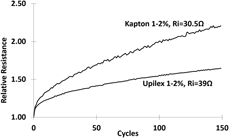Crossref Citations
This article has been cited by the following publications. This list is generated based on data provided by
Crossref.
Raj, Arun
Yadav, Manu
Adams, Nardeeka S.
Sivasubramony, Rajesh S.
Alhendi, Mohammed
Poliks, Mark
and
Borgesen, Peter
2020.
Effects of Strain Rate and Dwell Time on Fatigue Damage Accumulation in Aerosol Jet Printed Nanosilver Traces on Flex.
IEEE Transactions on Components, Packaging and Manufacturing Technology,
Vol. 10,
Issue. 11,
p.
1938.
Garakani, B.
Somarathna, K. U. S.
Khinda, G.S.
Enakerakpo, E.
Alhendi, M.
Poliks, M.D.
Borgesen, P.
and
Alizadeh, A.
2020.
Effects of Process Parameters and Isothermal Fatigue Cycling on Electromechanical Properties of Screen-printed Interconnect on Nonwovens for Wearable Electronics.
p.
2167.
Alhendi, Mohammed
Sivasubramony, Rajesh S.
Weerawarne, Darshana L.
Iannotti, Joseph
Borgesen, Peter
and
Poliks, Mark D.
2020.
Assessing Current‐Carrying Capacity of Aerosol Jet Printed Conductors.
Advanced Engineering Materials,
Vol. 22,
Issue. 11,
Sivasubramony, R.S.
Alhendi, M.
Kokash, M.Z.
Yadav, M.
Raj, A.
Thekkut, S.
Enakerakpo, E.
Adams, N.
Borgesen, P.
and
Poliks, M.D.
2020.
Damage Accumulation in Printed Interconnects on Flex Under Combinations of Bending and Tension with Different Amplitudes.
p.
1225.
Somarathna, K. U. S.
Garakani, B.
Alhendi, M.
Enakerakpo, E.
Borgesen, P.
Poliks, M. D.
and
Alizadeh, A.
2020.
A Study of Electromechanical Behaviors of Printed Conductive Leads on Stretchable Textiles for Smart Clothing.
p.
2157.
Cestarollo, Ludovico
Alhendi, Mohammed
Sivasubramony, Rajesh Sharma
Khinda, Gurvinder Singh
Weerawarne, Darshana L.
Borgesen, Peter
Poliks, Mark D.
Stoffel, Nancy C.
and
Iannotti, Joe
2021.
Precision Dispensed Die Fillets as Nonconformal Surfaces for Printed Interconnects: Characterization, Optimization, and Mechanical Performance Assessment.
IEEE Transactions on Components, Packaging and Manufacturing Technology,
Vol. 11,
Issue. 4,
p.
683.
Raj, Arun
Sivasubramony, Rajesh Sharma
Yadav, Manu
Thekkut, Sanoop
Khinda, Gurvinder Singh
Alhendi, Mohammed
Poliks, Mark D.
and
Borgesen, Peter
2021.
Aging and Fatigue of Aerosol Jet-Printed Nano-Ag Traces on Flexible Substrate .
Journal of Electronic Packaging,
Vol. 143,
Issue. 2,
Sivasubramony, Rajesh Sharma
Kokash, Maan Zaid
Thekkut, Sanoop
Shahane, Ninad
Thompson, Patrick
Mirpuri, Kabir
Kawana, Yuki
Greene, Christopher M.
and
Borgesen, Peter
2022.
Fatigue Testing of Copper Nanoparticle-Based Joints and Bonds.
Journal of Electronic Packaging,
Vol. 144,
Issue. 1,
